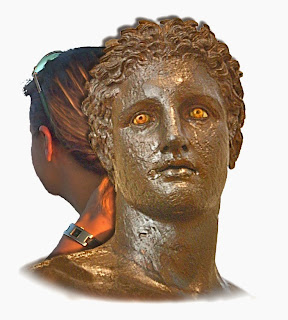Someone asked me the other day where the main character in The Boy with Two Heads comes from, and whether I made him up. We were talking about a new review that has appeared on the Amazon page for The Boy, for which I am very grateful. It is short and to the point:

Good Plot in ancient greece
This was a very engaging read. Lovers of the Grecian era will find it interesting, and the blog is a good twist. Should appeal to teens.
(by Prudence, who gives it five stars)
Thank you, Prudence!
I was very glad to see your last sentence. I specifically wrote The Boy with Two Heads for today's teenagers, because it seems to me that their only contact with Greek gods and heroes these days is through exciting fantasies like those about Percy Jackson by Rick Riordan in which the gods and heroes are active characters.
I was very glad to see your last sentence. I specifically wrote The Boy with Two Heads for today's teenagers, because it seems to me that their only contact with Greek gods and heroes these days is through exciting fantasies like those about Percy Jackson by Rick Riordan in which the gods and heroes are active characters.
In museums all over the world, there are thousands of representations of Apollo and Hermes and Poseidon (and Herakles and Athena, and so on) on vases or sculpted in stone, wood, or other precious materials, as if they were real people who walked the streets with the ordinary populace. They may have been based on memories of real heroes or explanations for strange historical happenings, but from the literature we have from 700 BC onwards, we know it was generally accepted that you were unlikely to meet any of them in the flesh, though they influenced all aspects of life.
I wanted to answer the question "What was it really like to live in Athens in the 5th century BC?" - partly because I spent more than 20 years of my own life there in the 20th century AD! I wanted to write a story about a link between now and then. It was to involve only real people and could happen to you or me at any time.
| Apollo. Olympia Museum. |
 |
| Hermes and baby Dionysos Olympia Museum |
 |
| Athena Metropolitan Museum New York City, USA |
 |
| Poseidon or Zeus National Archaeological Museum, Athens |
 |
| Herakles and the Stymphalean Birds. British Museum, London. |
I wanted to answer the question "What was it really like to live in Athens in the 5th century BC?" - partly because I spent more than 20 years of my own life there in the 20th century AD! I wanted to write a story about a link between now and then. It was to involve only real people and could happen to you or me at any time.
For years I've been reading (in small doses, I must admit) what was actually written by the writers of those times. I've read about wars and theatres and laws and gods and myths, all translated from the ancient Greek texts. Repeatedly I come across the ancient Olympic Games. These are held up, among other things, as the ultimate way to worship Zeus the father of the gods, as motivation for young men to train hard, and as the framework for the calendar in some parts of Greece with their four-year cycle. They were very important.
So, when I found the long description of Ancient Olympia, written in 160 AD (in Pausanias' Guide to Greece, translated by Peter Levi), I was entranced by the descriptions of the temples with their glorious and gaudy treasures and statues of gods and goddesses, even though they were written 500 years after the period I was researching.
 |
| Altis of Olympia, in 2000 Temple of Zeus centre front, stadium top right. |
However, after ten pages or so, I was beginning to feel grateful that, as he says, "not all Olympic winners have their statues standing at Olympia". One long paragraph about all-in wrestlers who won by bending their opponents' fingers until they broke (or the other man gave in), made me feel I had had enough for one sitting.
But my eye strayed to the beginning of the next paragraph. "For the sake of Pheidias and his genius as a sculptor, I must introduce here the boy tying a ribbon round his head, although we have no idea whose portrait Pheidias's statue is."
And there he was...
I had a real hero, his story already half-made in my imagination.
I had a real hero, his story already half-made in my imagination.
 Thus, through Pausanias, I met a real person (not a hero or a god), sculpted by a real sculptor, but without a name or history. He had stood for 500 years in the precinct at Olympia until at least 160 AD, although now there is no sign of him.
Thus, through Pausanias, I met a real person (not a hero or a god), sculpted by a real sculptor, but without a name or history. He had stood for 500 years in the precinct at Olympia until at least 160 AD, although now there is no sign of him.So I kidnapped him. I called him Themistokles, son of Kallistos of Diomea in Athens, and later in the story he became known as The Boy with Two Heads, (although only one was visible!) ...
The statue we used to represent Themis is described earlier in this blog: on February 5th 2012,
and on February 8th 2013.
The vase paintings above are from http://www.theoi.com/Gallery/M1
and on February 8th 2013.
The vase paintings above are from http://www.theoi.com/Gallery/M1
The picture of the statue of Poseidon or Zeus is from Wikipedia: http://en.wikipedia.org/wiki/Artemision_Bronze
No comments:
Post a Comment